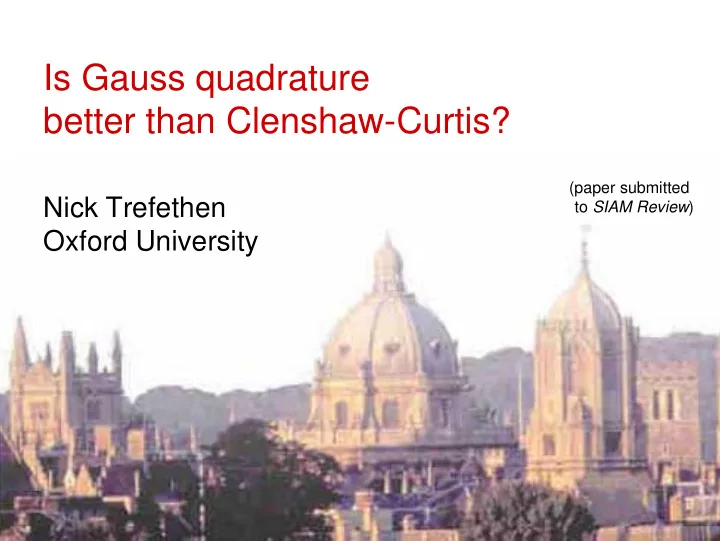

Is Gauss quadrature better than Clenshaw-Curtis? (paper submitted Nick Trefethen to SIAM Review ) Oxford University
For f ∈ C[ − 1,1], define n ∑ 1 ∫ I n = I = w k f ( x k ) f ( x ) dx , − 1 k =0 where { x k } are nodes in [ − 1,1] and { w k } are weights such that I = I n if f is a polynomial of degree ≤ n . ∞ ∞ → → n s a s e g e r v d i Newton-Cotes: x k = − 1 + 2 k / n n ) o n e m o n e h p e g n u R ( Clenshaw-Curtis: x k = cos( k π / n ) ∞ ∞ → → n s a s e g e r v n o c Gauss: x k = k th root of Legendre poly P n +1 ∞ ∞ → → n s a s e g e r v n o c C-C is easily implemented via FFT (O( n log n ) flops). Gauss involves an eigenvalue problem (O( n 2 ) flops). (HANDOUT)
We think of Gauss as “twice as good” as C-C: THEOREM best approximation errors for C-C: | I − I n | ≤ 4 E n * polynomials of degrees n , 2 n +1 Gauss: | I − I n | ≤ 4 E 2n+1 * Yet in experiments, this factor of 2 often doesn’t appear.
In fact, Gauss beats C-C only for functions analytic in a big neighborhood of [ − 1,1]. And even then rarely by a full factor of 2.
The Gauss ≈ C-C phenomenon was noted by O’Hara and Smith ( Computer J. 1968), but no theorems were proved. Here’s a theorem. (“Variation” involves a certain Chebyshev- weighted total variation, and C = 64/15 π .) THEOREM. Let f ( k ) have variation V < ∞ . Then for n ≥ k /2, the Gauss quadrature error satisfies | I − I n | ≤ C k − 1 (2 n +1 − k ) − k . ( ∗ ) THEOREM. For suff. large n , the C-C error satisfies ( ∗ ) too! Proofs: based on Chebyshev coefficients and aliasing. But really I came here to show you some pictures.
Suppose f is analytic on [ − 1,1]. Let Γ be a contour in the region of analyticity of f enclosing [ − 1,1]. The following identity was used e.g. by Takahasi and Mori ≈ 1970 but more or less goes back to Gauss. (See Gautschi’s wonderful 1981 survey of G. quad. formulas.) THEOREM. For any interpolatory quadrature formula with nodes { x k } and weights { w k } , ∫ Γ I − I n = (2 π i) − 1 f ( z ) [ log(( z +1)/( z − 1)) − r n ( z ) ] where r n ( z ) is the type ( n , n +1) rational function with poles { x k } and corresponding residues { w k } . Proof: Cauchy integral formula. So convergence of a quadrature formula depends on accuracy of rational approximations: log(( z +1)/( z − 1)) ≈ r n ( z ) .
Contour lines | log(( z +1)/( z − 1)) − r n ( z ) | = 10 0 , 10 − 1 ,10 − 2 , … (from inside out) n = 32 For Gauss quadrature, there are Scallops reveal interpolation points — 2 n +3 interpolation points, all at ∞ n − 2 of them (as well as n +3 at ∞ ) Thus r n is a Padé approximant. (This is how Gauss himself derived Gauss quad.!)
Contour lines | log(( z +1)/( z − 1)) − r n ( z ) | = 10 0 , 10 − 1 ,10 − 2 , … n = 64
Interpolation pts — zeros of log(( z +1)/( z − 1)) − r n ( z ) n = 16 n = 8 n = 32 n = 64 Weideman has shown that these ovals are close to ellipses of semiaxis lengths 1 and 3 log n / n .
Interpolation pts — zeros of log(( z +1)/( z − 1)) − r n ( z ) n = 16 n = 8 I suspect the essence of the matter n = 32 n = 64 is potential theory — “balayage” Weideman has shown that these ovals are close to ellipses of semiaxis lengths 1 and 3 log n / n .
These observations suggest a prediction: C-C is as good as Gauss when the region of analyticity of f is smaller than the magic oval. This is just what we observe. We finish with an experiment to illustrate.
Same experiment as before, carried to higher n . As n increases, the oval shrinks and cuts across the pole of f . Thus Weideman’s analysis explains why this kink appears where it does. Paper to appear.
Recommend
More recommend